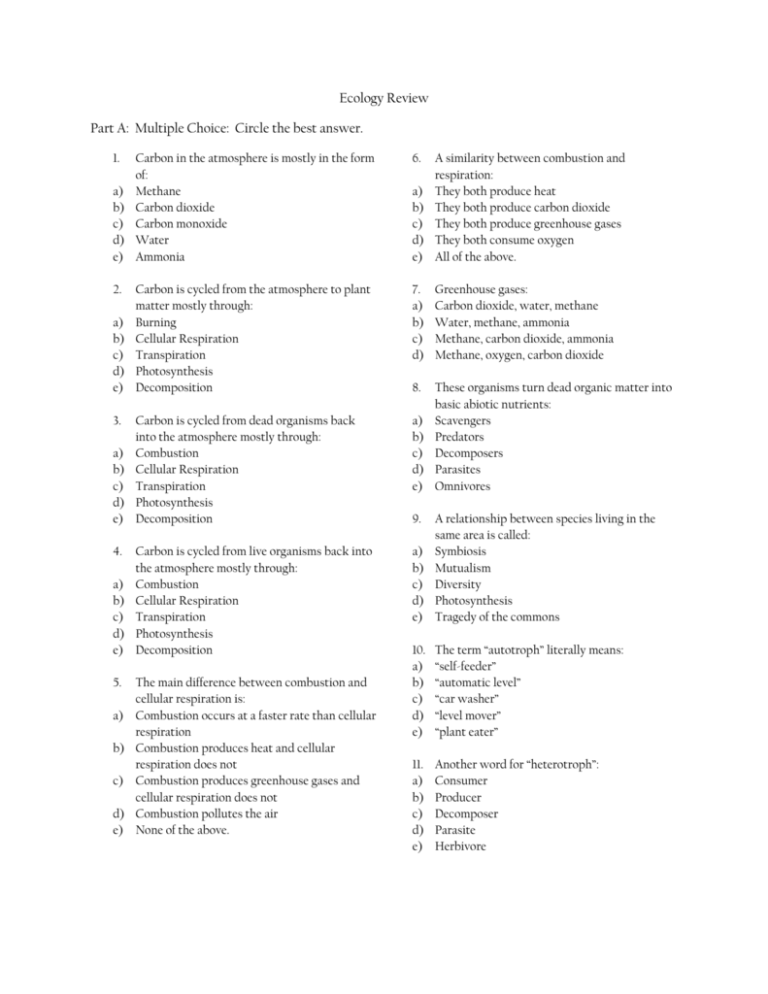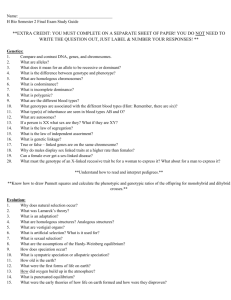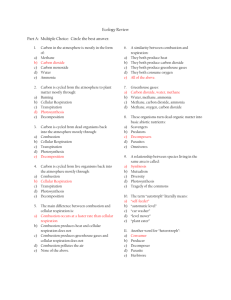Eco Review Quiz - hhs
advertisement

Ecology Review Part A: Multiple Choice: Circle the best answer. 1. a) b) c) d) e) 2. a) b) c) d) e) 3. a) b) c) d) e) 4. a) b) c) d) e) 5. a) b) c) d) e) Carbon in the atmosphere is mostly in the form of: Methane Carbon dioxide Carbon monoxide Water Ammonia 6. a) b) c) d) e) A similarity between combustion and respiration: They both produce heat They both produce carbon dioxide They both produce greenhouse gases They both consume oxygen All of the above. Carbon is cycled from the atmosphere to plant matter mostly through: Burning Cellular Respiration Transpiration Photosynthesis Decomposition 7. a) b) c) d) Greenhouse gases: Carbon dioxide, water, methane Water, methane, ammonia Methane, carbon dioxide, ammonia Methane, oxygen, carbon dioxide 8. Carbon is cycled from dead organisms back into the atmosphere mostly through: Combustion Cellular Respiration Transpiration Photosynthesis Decomposition a) b) c) d) e) These organisms turn dead organic matter into basic abiotic nutrients: Scavengers Predators Decomposers Parasites Omnivores Carbon is cycled from live organisms back into the atmosphere mostly through: Combustion Cellular Respiration Transpiration Photosynthesis Decomposition a) b) c) d) e) A relationship between species living in the same area is called: Symbiosis Mutualism Diversity Photosynthesis Tragedy of the commons 10. a) b) c) d) e) The term “autotroph” literally means: “self-feeder” “automatic level” “car washer” “level mover” “plant eater” 11. a) b) c) d) e) Another word for “heterotroph”: Consumer Producer Decomposer Parasite Herbivore The main difference between combustion and cellular respiration is: Combustion occurs at a faster rate than cellular respiration Combustion produces heat and cellular respiration does not Combustion produces greenhouse gases and cellular respiration does not Combustion pollutes the air None of the above. 9. 12. a) b) c) d) e) This material is rich in nitrogen: Methane Carbon dioxide Water The lithosphere Manure 13. a) b) c) d) e) The chemical symbol for ammonia is: CH4 CO2 H2O NH4 C6H12O6 14. This process requires carbon dioxide and water and produces oxygen a) Photosynthesis b) Cellular respiration c) Combustion d) Farting e) Peeing 15. a) b) c) d) e) At the bottom of a food chain, web or pyramid: Producers Primary consumers Secondary Consumers Top predators Parasites 16. a) b) c) d) e) Three examples of biomes: Scavengers, predators, decomposers Grasslands, aquatic, desert Pond, river, lake Lithosphere, atmosphere, hydrosphere None of the above 17. a) b) c) d) e) Another word for non-native: Invasive Exotic Indigenous Parasitic Autotrophic 18. a) b) c) d) e) Not a decomposer: worm vulture bacteria fungus millipede 19. A _________________ consumes primarily animals that are recently killed by another species: a) decomposer b) scavenger c) parasite d) herbivore e) consumer 20. Cows add to the greenhouse effect most strongly by: a) Producing manure b) Eating grass c) Farting d) Breathing oxygen e) Respiration 21. Certain birds clean the ears of water buffalo by eating fleas that nest in the ear. This is an example of: a) Predation b) Commensalism c) Mutualism d) Competition e) Bilingualism 22. a) b) c) d) e) Put in order from smallest grouping to largest: Ecosystem, biome, community, population Biome, ecosystem, community, population Community, population, ecosystem, biome Population, community, ecosystem, biome Community, ecosystem, population, biome 23. This organism belongs to more than one trophic level: a) Dandelion b) Rabbit c) Cow d) Human e) None of the above 24. A robin eats insects and worms and builds nests in trees using bits of fallen branches and loose grass. It can be preyed on by cats. This describes the robin’s : a) Niche b) Habitat c) Community d) Population e) Gender 25. In a dense jungle, taller trees get the most sunlight. This is an example of: a) Mutualism b) Commensalism c) Predation d) Parasitism e) Competition 28. a) f) g) h) i) Which of the following is FALSE? All invading species are introduced All introduced species are invasive All introduced species are native All native species are exotic None of the above. 26. Examples of abiotic limiting factors: a) Food availability, water availability, climate b) sunlight availability, water availability, temperature c) number of predators, oxygen level, climate d) living space, food availability, availability of mates e) none of the above 29. A pond can support a dozen or so turtles before it begins to get too crowded. Any more than this and the food supply will start to become scarce. This is an example of: a) Carrying capacity b) The greenhouse effect c) An engineered ecosystem d) The tragedy of the commons e) Biodiversity 27. Which of the following is TRUE? Introduced species are: a) all brought on purpose from another land b) all invasive in their new land c) all non-native d) never able to adapt to the new environment e) always top of the food chain. 30. In a food web: a) Producers are at the bottom b) Arrows indicate the direction of feeding (i.e. from food to consumer) c) Some organisms have multiple arrows d) Sldkj e) Lskdjf Long Answer Questions: 1. 2. 3. 4. 5. 6. 7. 8. 9. 10. Explain the difference between a law, a theory and a hypothesis. What is the origin of all energy on Earth? What is a biome? Explain the greenhouse effect. Explain why decomposers are so important in the carbon and nitrogen cycle. What is the primary difference between a community and an ecosystem? Draw the carbon cycle. Name 3 carbon sinks. Explain why North Americans demand for beef is a direct cause of global warming. Give an example of a limiting factor that becomes more of a factor with increasing population density. 11. Give an example of a limiting factor that becomes more important as population decreases. 12. Give an example of a limiting factor that is not affected by population density. 13. If the rabbit population in a certain area were suddenly rid of predators (wolves, fox, coyote, hawks etc.) what would happen in the short and long term? 14. Write the equation for photosynthesis as a : a) Word equation b) Chemical equation c) Balanced chemical equation. 15. Repeat the previous question for cellular respiration. 16. Explain the greenhouse effect and global warming. 17. Why are the carbon cycle and nitrogen cycle important for the survival of our planet? 18. Explain the tragedy of the commons as it applies to a specific environment or ecosystem. 19. Explain why biodiversity is important for an ecosystem to be healthy. 20. Explain how bioengineered ecosystems can upset the local ecosystem.







